What follows is the 2019 edition of my annual Year in Bedlam overview of the best and worst of the previous year’s filmic output, along with recommended DVD releases and a brief look at some interesting sounding upcoming films. As always, it covers only those films commercially released in the US, which, you’ll find, encompasses plenty of interesting obscurities in addition to the commercial releases. I’ve attempted to include a good sampling of both, although of course I was unable to see every potentially worthwhile film released in 2019 (notable omissions include GLASS, DOCTOR SLEEP and IT: CHAPTER 2, all of which I wanted to see but for various reasons didn’t).
One more thing: a number of my readers were confused by last year’s Year in Bedlam due to the fact that its format was so different from the retrospective pre-2001 YIB listings I’ve been posting. Those, of course, are quite limited in scope (due to the fact that too much time has passed to allow for a proper overview of those past years), whereas this one, like its post-2001 fellows, is more expansive, encompassing all the 2019 films I’ve seen, starting with…
The Best
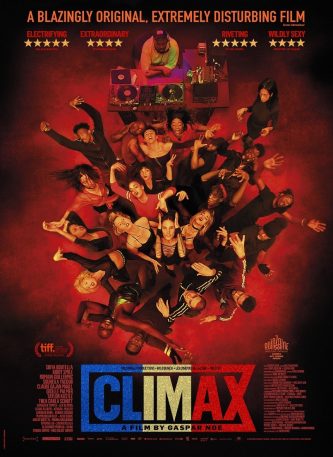 1. CLIMAX
1. CLIMAX
A film whose overall gist is telegraphed in an early scene depicting a TV screen with several VHS tapes stacked beside it, among them POSSESSION, UN CHIEN ANDALOU, SUSPIRIA and SALO—films that (for those of you who don’t already know) are scary, freakish and bizarre, adjectives that adequately sum up CLIMAX. That shouldn’t surprise anyone given that the writer and director was Gaspar Noe, who’s not exactly known for his refinement. Here Noe regains the grandeur of his early features I STAND ALONE and IRREVERSIBLE (and improves greatly upon the much lesser ENTER THE VOID and LOVE), even if CLIMAX is a comparatively restrained effort, with sex scenes that are plentiful but non-explicit and violence that never goes beyond a bout of mild self-mutilation. It’s about a Gallic dance troupe who gather in a ballroom decorated with a giant French flag to rehearse. But around the film’s halfway point (at which time the opening credits are finally shown, the end titles having been rolled in the opening five minutes) we learn that the sangria the dancers have been imbibing was spiked with LSD. What follows is a literal descent into Hell as the red portion of the French flag comes to increasingly predominate, and everyone in sight turns into screaming and convulsing maniacs—all captured in a single, irrepressible shot (much of it upside-down). Only Gaspar Noe, whose filmmaking mastery is fully on par with his taste for the aberrant, could have pulled off such an unspeakably crazed concoction. He even coaxes decent-to-strong performances out of his largely inexperienced cast, in a film that must rank as one of the most bewildering, upsetting and, finally, satisfying cinematic freak-outs of recent years.
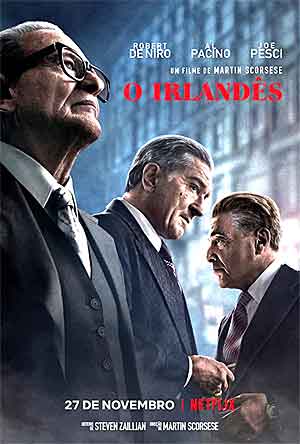 2. THE IRISHMAN
2. THE IRISHMAN
The Irishman is a veritable greatest hits package of Martin Scorsese gangster movie elements packed into an irresistible three-and-a-half-hour whole. The subject is Frank Sheeran, the mob connected bodyguard to Jimmy Hoffa. Sheeran is played by Robert De Niro and Hoffa by Al Pacino, with Joe Pesci and Harvey Keitel in supporting roles, ensuring that the film reaches mob movie nirvana (and improves greatly on the horrendous Danny De Vito directed HOFFA from 1992). A freewheeling, precedent-smashing (i.e. gangster-ish) style? Check. A complex decades-spanning narrative? Check. A shooting/beating/blowing up every few minutes? Check. A goodly amount of east coast accented profanity? Check. There is admittedly a bit less of the kinetic energy that distinguished GOODFELLAS and CASINO, which is by design. Old age is one of THE IRISHMAN’S major themes, opening and closing as it does with Sheeran as a codger looking back over his life, thus providing a variety of flashbacks of the principal characters at various ages, and allowing for some ground-breaking ageing effects. The fact that I didn’t notice those effects is a testament to their effectiveness, and also to the fact that the performances are so seamless—with Pacino, for once, getting a showier role than De Niro.
3. ONCE UPON A TIME…IN HOLLYWOOD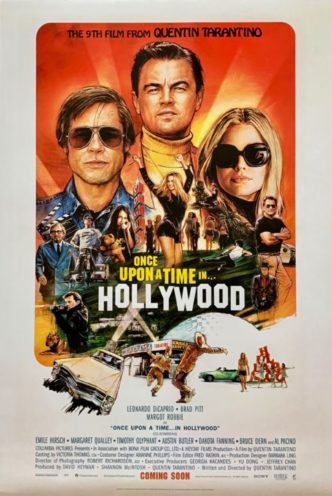
A grand epic that offers up an alternately poignant and exploitive depiction of Manson-era Hollywood, as seen through the eyes of the one and only Quentin Tarantino. It’s an unabashed love letter to a very specific time and place, inspired in large part by Tarantino’s own childhood memories (which explains why so much of it consists of people watching TV). Thus the production design, which sumptuously recreates late-1960s Tinseltown, and vintage rock tunes that play throughout (for once in a 1960s set movie “Time of the Season” and “Get Together” aren’t heard) assume the status of characters in their own right. That’s a good thing, because the protagonists, played by Leonardo Di Caprio as a has-been TV star and Brad Pitt as his stuntman sidekick, aren’t nearly as interesting as Tarantino seems to think they are. But with so much here that’s so fine, including a top flight supporting cast headed by Margot Robbie (as Sharon Tate), Dakota Fanning (as Squeaky Frommel) and Margaret Qualley (as a leggy Manson family member), and a ferocious stunner of an ending, I won’t complain too much.
4. BIRDS OF PASSAGE (PAJAROS DE VERANO)
2019’s other major crime saga, a Columbian made depiction of the 1970s marijuana trade, viewed from ground zero. The overall arc will be familiar to viewers of THE GODFATHER and SCARFACE, but this film’s setting, attitude and stylistic choices are completely unique. Far from the jungle scenery you might expect given that it takes place in Columbia, the majority of the film is situated in an arid desert, where a staunchly tradition-bound clan resides. The early scenes, depicting the odd (to us gringos) practices and rituals of said clan, seem more anthropological than crime movie oriented, yet the directors Cristina Galego and Caro Guerra gradually draw the viewer into a tightly wound fact-based narrative. It involves a young man (Jose Acosta) living in the late 1960s who, attempting to woo one of the clan’s young women (Natalia Reyes), involves himself in the marijuana selling business in order come up with the exorbitant sum demanded by Reyes’s mother. Acosta quickly rises from a plucky upstart to a full blown drug kingpin, which brings great wealth to his new family, who build a wholly incongruous luxury compound in the middle of the desert, but also tears the clan apart and spreads brutality and corruption far and wide. What’s especially interesting about this film is that it never loses the calm and observant aura of the early scenes even as it grows increasingly violent and intense, presenting its mayhem with the same placid contemplation as it does the native dances performed by Ms. Reyes.
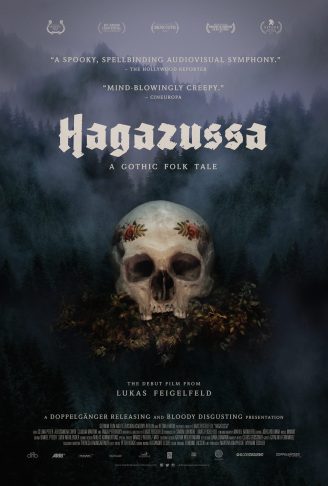 5. HAGAZUSSA
5. HAGAZUSSA
This Austrian import is unquestionably the state of the art in middle ages set depictions of superstition and black magic. It’s far superior, in other words, to the better known THE WITCH (a film everyone seems to like but me). HAGAZUSSA is everything that overrated muddle wanted to be: authentically dark, challenging and atmospheric, set in a richly detailed 15th Century milieu with VERY scant dialogue. The pacing is extremely deliberate (to the point that one imdb user likened the film to a series of moving paintings) and the narrative quite teasingly enigmatic. It involves a young woman whose mother was persecuted as a witch turning to the black arts herself. She also kills her infant child in a profoundly disturbing, hallucinatory sequence that adequately encapsulates the film’s oft-kilter gist. A demanding viewing experience, to be sure, but a fascinating one for those willing to meet HAGAZUSSA on its own terms.
6. THE LIGHTHOUSE
This ultra-claustrophobic two character psycho-fest was directed by Robert Eggers, of THE WITCH (about which my feelings are summed up in the previous entry). THE LIGHTHOUSE is an uncredited remake of the 1929 suspense drama THE LIGHTHOUSE KEEPERS, albeit with a more horrific overlay. Robert Pattinson and Willem Dafoe headline as lighthouse keepers going slowly bonkers during a particularly stormy sojourn in the titular abode, with nightmarish hallucinations, ever-shifting power games, homoeroticism, brutality and an odd co-dependency all making themselves apparent. Both actors are exemplary, as is the stately—possibly a bit too stately—black and white photography and authentic feeling production design. In short, I don’t have much to complain about here, even though the film, for whatever reason, didn’t excite me as much as it could have.
7. JOKER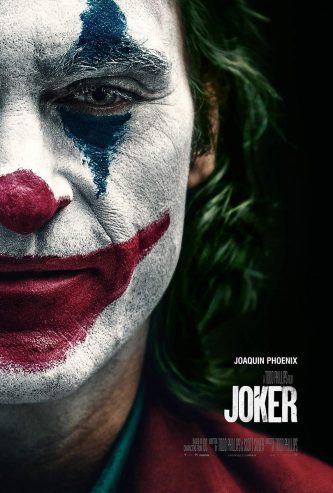
The idea of marrying the DC Universe with the cinema of Martin Scorsese—KING OF COMEDY in particular—was a brilliant one. Joaquin Phoenix plays the titular Batman antagonist, presented here as an aspiring comedian who idolizes a smarmy late night talk show host (Robert De Nero) and is constantly stymied in his quest for fame by, among other things, his own unquiet mental state. Phoenix is brilliant and director Todd Phillips conjures a convincingly sordid atmosphere of big city grit. Much ink has been spilled about the film’s extreme violence, although in truth the brutality here isn’t all that shocking or unprecedented (THE IRISHMAN and ONCE UPON A TIME…IN HOLLYWOOD outdo it in nastiness). What’s especially striking is how Phillips audaciously updates the Batman mythos to our age, a process that isn’t without some hiccups (the shooting of Bruce Wayne’s parents, for instance, which feels tacked-on), but works smashingly well overall.
8. PARASITE (GISAENGCHUNG)
The mainstream attention this South Korean film has received is surprising given that it’s a dark and twisted affair very much in keeping with the filmography of its writer-director Bong Jon Ho (which includes the non-family friendly likes of MEMORIES OF MURDER, THE HOST and MOTHER). It also happens to be quite potent in its depiction of a destitute family of basement dwellers ingratiating themselves into the opulent household of a much wealthier clan, unaware that the house in question is harboring a malevolent secret (with the basement motif extended considerably). That’s all I’ll reveal of the highly imaginative narrative, which is best experienced without any preconceptions. Quite a few pertinent social issues are raised in a film that never feels preachy, enveloping its audience in a lively, black humor tinged succession of events that are suspenseful and shocking by turns. Yes, there are some upsetting bits, particularly in the second half, in which the penniless protagonists we’ve come to root for engage in some downright despicable actions—yet somehow maintain our sympathy from start to blood-spattered finish.
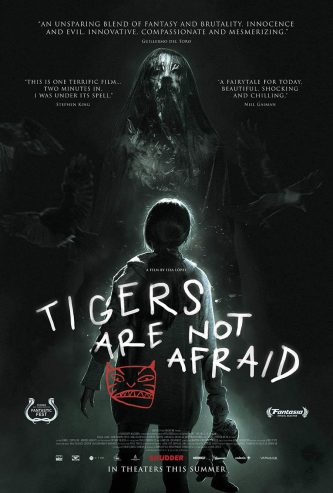 9. TIGERS ARE NOT AFRAID (VUELVEN)
9. TIGERS ARE NOT AFRAID (VUELVEN)
Fairy tales meet a truly brutal reality in this Mexican made near-masterwork from writer-director Isa Lopez. About an orphaned girl (Paola Laura) attempting to navigate an increasingly unforgiving reality together with four similarly afflicted boys, it works as both a poignant depiction of the human costs of Mexico’s drug wars and a near-surreal evocation of a child’s inner world. Fairy tale enchantment plays a large part in this particular world, in which Laura is assailed by ghosts of the recently deceased and a gravity-defying trail of blood. Far more horrifying are Laura’s outer surroundings, in which several of her young friends are gunned down and she herself is forced to commit (or at least take credit for) an unspeakable act. Powerful stuff, but the film is let down by Lopez’s insistence on imposing a conventional narrative structure, complete with a stolen cell phone (the “McGuffin”) and an ersatz happy ending, which undercut the sense of realism considerably.
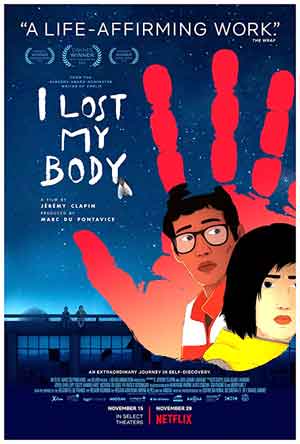 10. I LOST MY BODY (J’AI PERDU MON CORPS)
10. I LOST MY BODY (J’AI PERDU MON CORPS)
It’s good to see that, in this age of endless remakes, reboots and regurgitations, a film of whacked-out originality is still possible. I LOST MY BODY is an animated feature from France centering on a severed hand making its way through the streets and gutters of Paris, presumably in search of its host body. Intercut with the hand’s oft-unpleasant exploits are the misadventures of an idealistic pizza delivery man attempting to woo an attractive young woman. The connection between the appendage and the man is made evident near the end of the film, which is notable for old school hand drawn animation that verges on primitive (and has drawn a number of complaints about its “low budget” look). I found the animation refreshing amid the overly slick computerized visuals of most modern cartoon movies, and also appreciated the painstaking attention to detail paid by the animators (when the protagonist picks up a pizza box in one scene they’re careful to show him putting it back down, complete with an accompanying sound effect). What I LOST MY BODY, with its blunt and unsentimental worldview (in which love does not conquer all), lacks is a satisfying conclusion. I have no problem with unhappy endings, but this film’s inconclusive denouement flat-out sucks.
11. DOLEMITE IS MY NAME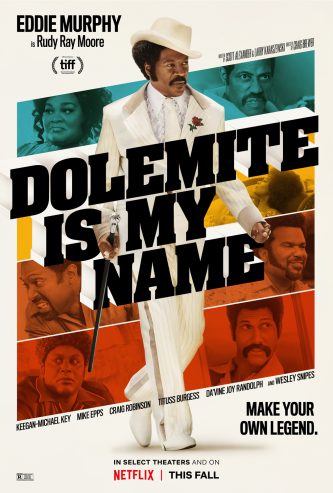
Eddie Murphy delivers his finest performance in I-don’t-know-how-long in this Netflixer about the late Rudy Ray Moore, who established himself as the black Ed Wood in 1970s trash-earpieces like DOLEMITE and THE HUMAN TORNADO. DOLEMITE IS MY NAME was scripted by Larry Karaszewski and Scott Alexander, who previously did the same for ED WOOD and THE PEOPLE VERSUS LARRY FLYNT, and this is a worthy addition to their retinue of “anti-great man” biopics. I’m not sure that Murphy nails Moore (an unattractive and obnoxious fellow) all that accurately, but his natural charisma serves him well in playing a man whose primary “talent,” as portrayed here, was his ability to hustle. Depictions of Moore’s unique comedy stylings, which led to him being dubbed the “godfather of rap,” are included, but the film is primarily interested in the rocky inception of DOLEMITE, which is vividly, and hilariously, portrayed. The cast includes Wesley Snipes as the film’s pretentious director, Kodi Smitt-McPhee as its eager film school cinematographer, and Snoop Dogg and Chris Rock as DJs, all of whom admirably hold their own alongside the imposing Mr. Murphy.
12. 1917
2019 was a year in which seemingly everyone in the film world wanted to be Stanley Kubrick. We saw it first in AD ASTRA, a.k.a. 2001-lite, and now 1917, in which AMERICAN BEAUTY’s Sam Mendes tries his hand at replicating PATHS OF GLORY. The attempt doesn’t come off, with the film’s elaborate tracking shots through the trenches and battlefields of WWI—the overriding gimmick being that it was shot in a single take (with hidden cuts)—feeling distracting and show-offy. But the film gets points for its spare and consistently unpredictable narrative about two British soldiers on a mission through enemy territory to deliver a missive. This is a film in which literally anyone can die at any time, in a superbly rendered atmosphere of harshness and desolation. The dialogue is spoken in VERY thick English accents that are often difficult to decipher, although the acting, especially by the leads George MacKay and Dean-Charles Chapman, can’t be faulted.
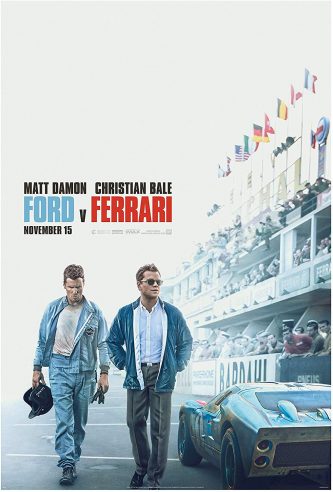 13. FORD V FERRARI
13. FORD V FERRARI
Unabashedly commercial, stand-up-and-cheer moviemaking. When this stuff works it works, and this is definitely such an occasion. Matt Damon plays Carroll Shelby, a car designer, and Christian Bale is Ken Miles, a race car driver, who were recruited by the Ford Company to build the fastest race car in the world, and then enter it in the 1966 Le Mans race, the previous four of which were won by Ferrari. The film is brilliantly directed by James Mangold, with expertly shot and edited race scenes, unobtrusive period detail and a fine, unforced chemistry between the lead actors—which nearly offset the fact that the script is riddled with clichés and inconsistencies. The character of Bale’s long suffering wife (Caitriona Balfe) is one such cliché/inconsistency, spending much of the film’s first half whining (in the manner of most Great Man movie wives) about the danger to which her hubbie constantly exposes himself, only to capitulate eventually because that’s what the script decrees.
14. THE LAUNDROMAT
THE BIG SHORT (2015) appears to have been the major inspiration for this fact-based quasi-comedy, featuring Meryl Streep as a woman attempting to sort out an insurance scam who uncovers a mess of fraudulent activity orchestrated by a pair of scumbag lawyers. Gary Oldman and Antonio Banderas play the latter, and provide onscreen narration in which they outline the various mechanisms used by individuals and corporations to evade taxes—information that’s largely incomprehensible to most people but which this film (as THE BIG SHORT did with stock market manipulation) does its damndest to render in intelligible fashion. This makes for an extremely fragmented and episodic narrative that features guest appearances by a retinue of recognizable folk (Sharon Stone, Melissa Rauch, Robert Patrick, David Schwimmer, James Cromwell, Jeffrey Wright, Rosalind Chao). There’s also a wholly odd gimmick of having Streep play a second character, which may have been intended to be unconvincing and silly—that’s certainly how it comes off—or perhaps not. The film, in any event, handily accomplishes its overriding goal: keeping the viewer entertained and more than a little enraged at just how insanely lopsided and plain screwed up America’s so-called democracy has become.
15. US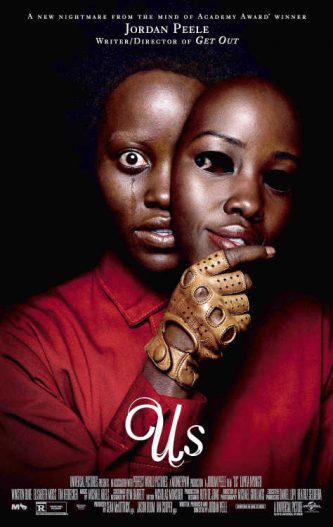
Jordan Peele’s follow-up to GET OUT was highly overrated by critics, but is affecting nonetheless. Its narrative isn’t as strong as that of the previous film, yet still offers a novel twist on the standard home invasion horror movie trope, with a vacationing black family finding themselves under siege by another family who look just like them. There’s a highly involved backstory involving the family matriarch (Lupita N’Yongo) that somehow also works in the 1986 Hands Across America hand holding gambit and (of course) a great deal of grue that the protagonists, in direct contrast to those of most horror movies (in which black people are usually the first to be killed), are able to effectively navigate and eventually overcome. The film is never as deep or insightful as it thinks it is, but taken purely as an eccentric splatter fest it works just fine.
16. RICHARD JEWELL
Another example of a TV movie—a good one!—given big screen treatment. Clint Eastwood was the director, and provides an engrossing depiction of the ordeal of the late Richard Jewell, who identified a nail bomb at the 1996 Olympics, and saved a number of lives by helping to clear the area, only to be vilified by the FBI and a ravening media. Certain pundits have criticized Eastwood for the film’s blanket condemnation of the FBI and the news media, but speaking as one who vividly recalls what occurred back in ‘96 (which was pretty damn ugly) I say the film gets the atmosphere exactly right. The one element that feels false and sensationalistic is the portrayal of the late reporter Kathy Scruggs (played by Olivia Wilde), which has caused a fair amount of controversy, and is about on the level of the stereotypical white trash family presented by Eastwood in MILLION DOLLAR BABY. Other than that, though, RICHARD JEWELL’s elements are all quite solid, starting with a towering lead performance by Paul Walter Hauser, and excellent supporting turns by Kathy Bates as Jewell’s long-suffering mother and Sam Rockwell as his smart-assed attorney.
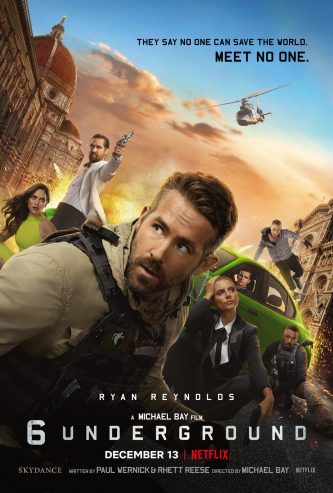 17. 6 UNDERGROUND
17. 6 UNDERGROUND
This Netflixer is unfiltered Michael Bay—or, in the words of its star Ryan Reynolds, the “Bay-est” film ever made. This means an irrepressible action fest that, in the absence of the PG-13 ratings with which Bay is usually constrained, thrives on excess in every department, from the over-exposed Victoria’s Secret commercial-worthy cinematography to the insanely overwrought chases and shootouts that pack the film, which invariably leave behind mountains of destroyed scenery and mangled corpses. Reynolds plays a rich sociopath who puts together a cabal of secret agents to take down a ruthless dictator in a variety of scenic European and Asian locales (not unlike a more hyped-up MISSION: IMPOSSIBLE). The narrative is only semi-coherent, relying on Reynold’s characteristic self-aware wisecracks, un-PC female pulchritude (with co-star Mélanie Laurent, of INGLOURIOUS BASTERDS, coming off like an overheated Sharon Stone) and of course all the action and violence to maintain momentum. I don’t know that I’d call it good, but it did unquestionably hold my attention.
18. KNIVES OUT
The publicity for this Rian Johnson reverie made it out to be a CLUE-like whodunit. The film’s overall concept—about a rich novelist (Christopher Plummer) murdered, it would seem, by one of his many disgruntled family members—appears to support the CLUE comparison, but it’s actually a far more intimate account that pivots less on who did it than how. The cast is a large and impressive one, consisting of Jamie Lee Curtis, Michael Shannon, Don Johnson, Toni Collette and others, yet the film is essentially a three-hander focusing on Daniel Craig as a Southern accented police investigator, Chris Evans as Plummer’s ultra-spoiled son and Ana de Armas as Plummer’s Brazilian maid, to whom he inexplicably leaves his entire fortune. It’s all reasonably absorbing, with a highly stylized, black-humored gist that’s necessary to contain the oft-goofy happenings (such as the utterance “Hugh” being mistaken for “You”), and bolstered by Armas’s wonderfully expressive close-ups. The narrative could frankly have been a little stronger; it is, once again, more concerned with how the murder went down rather than who committed it, and so lacks a show-stopping twist, yet does contain a Craig delivered climactic explanation that’s only slightly less convoluted than that of an entire season of MURDER SHE WROTE.
19. HIGH LIFE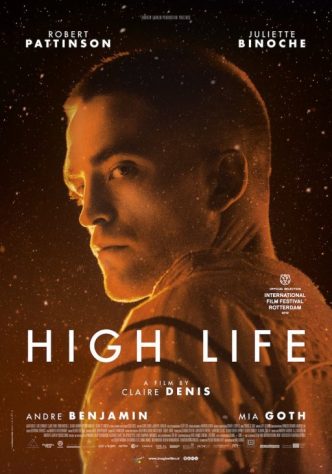
This is director Claire Denis’s best film in some time, and also the finest of the arthouse space operas (which included AD ASTRA and ANTARA) that clogged theaters in 2019. Slow, enigmatic and ominous—all Denis attributes—it’s a haunting depiction of loneliness and dissociation in the form of a claustrophobic outer space drama. The setting is a space ship upon which several criminals are stationed as part of a dimly explained fertility experiment headed by the resident MD Juliette Binoche, who it turns out is every bit as twisted and depraved as the felons she’s charged with supervising. The eruption of long-suppressed tensions and hostilities is a major theme, and leads to some truly disturbing violence, as well as some Lynchian bizarrie inside a room aboard the space ship in which the principals act out freaky sex fantasies. Eventually one of the criminals, played by Robert Pattinson, is humanized (somewhat) by the arrival of a daughter, a product of the fertility experiment who somehow develops a British accent after growing up in isolation with the American-accented Pattinson. No, not everything in this film adds up, but Denis’s gift for evocative imagery, added to an honest-to-goodness three act narrative (something Denis’s films tend to lack), is its own reward.
20. FREAKS
It’s best to approach this Vancouver lensed no budgeter with as little prior knowledge as possible. That was the state in which I viewed it, and I must say I was quite surprised by the constantly morphing narrative. It begins as a horror movie, with a little girl (Lexy Kolker) being held prisoner by her father (Emile Hirsch), who appears to be a paranoid nut. Also featured is Bruce Dern as a creepy ice cream truck driver who has a connection to Kolker and Hirsch that takes some time to become apparent, and a supernatural angle that helps justify the title (and has led to a lot of X-MEN comparisons). I’ll admit I was a bit underwhelmed by the final third, which is taken up with action and special effects for which the writer/directors Zach Lipovsky and Adam B. Stein lacked a proper budget. That aspect is evident in the cheap straight to video look that pervades the film and the not-always-stellar performances, with the endlessly inventive and ingenious script being FREAKS’S foremost attribute.
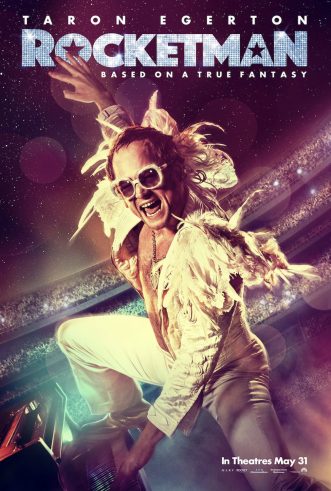 21. ROCKETMAN
21. ROCKETMAN
A movie that does for Elton John what last year’s BOHEMIAN RHAPSODY did for Freddie Mercury. It’s ultimately stymied by the same overriding problem that plagued the earlier film: the fact that its subject’s life just isn’t very interesting. As depicted here, Elton John’s existence hits all the expected notes: he had a (somewhat) impoverished childhood during which he demonstrated a talent for music and in later years took too many drugs, but ultimately cleaned up his act and found true love. The film is lively, at least, with a solid lead performance by Taron Edgerton and a script that (unlike BOHEMIAN RHAPSODY) fully faces up to its subject’s complex sexuality. Also, the music is good, with all of EJ’s major hits—“Crocodile Rock,” “Goodbye Yellow Brick Road,” “Saturday Night’s Alright,” “Don’t Let the Sun Go Down on Me,” etc.—given generous play, even if they’re sung more often than not by people other than Mr. John.
22. DARK WATERS
A fact-based crusading lawyer drama in the mold of ERIN BROCKOVICH, although DARK WATERS is far more hard-nosed in its approach. Directed by Todd Haynes, it tells the story of attorney Robert Bilott (played by Mark Ruffalo), who took on the chemical outfit DuPont for putting massive amounts of so-called “Forever chemicals” in its products—and in the process uncovered just how much the US government is in thrall to DuPont and other corporations. Haynes and his screenwriters make sure to press all the Crusading Lawyer movie buttons, with Bilott finding his dedication to taking down DuPont testing his wife (Anne Hathaway) severely, and also affecting his health, but of course he soldiers on, and eventually achieves satisfaction (of a sort). This isn’t a very pleasant or dramatically satisfying film, but it deserves to be seen.
23. LA FLOR
I’ll be nice and give this film a muted recommendation. It’s a massive project from Argentina’s Mariano Llinas, who over a multi-part fourteen hour canvas alternates moments of brilliance with passages of staggering self-indulgence. Mixing various different styles and genres, it resembles Llinas’s little-seen 2008 masterpiece EXTRAORDINARY STORIES, which had a comparatively economic 4 hour runtime and a tightly wound multi-narrative. LA FLOR, by contrast, has no evident rhyme or reason to its construction; an onscreen dissertation by Llimas in the film’s opening moments suggests that its various segments will eventually be tied together in a PULP FICTION-esque manner, but I never noticed any such tying-together. The sole connecting elements are the fact that the same four actresses headline each part. Llimas himself takes center stage toward the end, in which the proceedings grow increasingly self-reflexive. Llimas’s undeniable sense of cinema is on full display throughout much of the film—although definitely not in the unforgivable final portion, whose visuals are so indifferent and pedestrian they wouldn’t pass muster as home movie footage (the fact that this portion was apparently supposed to look crappy is scant compensation). The film also contains what is undoubtedly the longest end credits sequence (lasting nearly a full 40 minutes!) in film history. Again, I’m willing to grant Llimas this bit of cinemasturbation given his not-inconsiderable skill and ambition, but he’s edging dangerously close to Terrence Malick territory—i.e. to crawling up his own asshole and taking up permanent residence therein.
Recommended DVD/Blu-Ray Releases
BITTER MOON
Roman Polanski’s must-see 90’s sex comedy makes its long-awaited Blu-ray debut. It’s far from a definitive release in terms of extras, but is infinitely preferable to the previous DVD version.
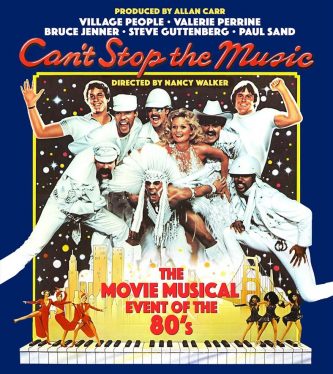 CAN’T STOP THE MUSIC
CAN’T STOP THE MUSIC
In contrast to the above entry, this jam-packed Blu-ray can safely be termed the definitive home video version of the film it digitizes, in this case the insane Allan Carr disco musical from 1980, a longtime Bedlam Files favorite.
HIGHWAY PATROLMAN (EL PATRULLERO)
One of the finest films by Alex Cox, a Spanish language cop thriller, makes its better-late-than-never Blu-ray debut!
THE JUNIPER TREE
The one and only Bjork-headlined medieval set downer is finally available in a restored version that is, needless to say, a massive improvement over the earlier VHS release.
KHRUSTALYOV, MY CAR! (KHRUSTALYOV, MASHINU!)
One of the great Russian films of our age, and a stand-out effort by the late Alexei German, whose dense black and white imagery is tailor made for the Blu-ray format.
KILLER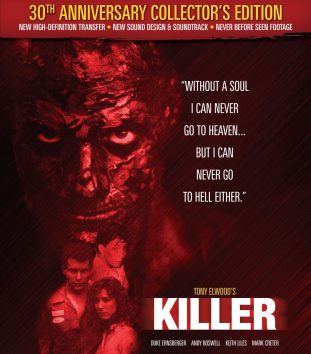
The 30th anniversary Blu-ray version of Tony Elwood’s no-budget classic KILLER presents the film in painstakingly restored form, ensuring that it looks better than it ever did before (including its initial 1989 release).
THE KILLER OF DOLLS (EL ASESINO DE MUNECAS)
I haven’t watched this one yet, but feel safe in recommending it based on the product description (which proclaims it a “bizarre and totally unique piece of Spanish horror”), and the fact that it was put out by Mondo Macabro, who have a good eye for interesting fare.
LA PRISONNIERE
A not-particularly-great-but-interesting-nonetheless film, LA PRISONNIERE was the last hurrah of France’s Henri-Georges Clouzot, who packs an otherwise standard-issue sex drama with striking psychedelic imagery.
MOON CHILD (EL NINO DE LA LUNA)
This horror-tinged fantasy by Spain’s Augusti Villaronga gets the jam-packed Cult Epics treatment, entailing the premiere release of the Dead Can Dance soundtrack cd in addition to the film itself.
THE NUN (LA RELIGIEUSE)
Jacques Rivette’s arty nunsploitation classic, starring the late Anna Karina, has yielded up what looks like a must-own, extras-packed Blu-ray by Kino Lorber.
PHANTOM LADY
A film noir classic that for some reason has been largely ignored on home video—until this Arrow Video release, which more than does it justice.
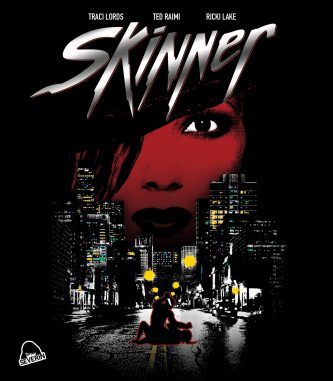 SKINNER
SKINNER
I’m not sure this excretion deserves its lovingly prepared Severin Blu-ray release, but here it is (I’m actually quoted on it, calling the film “gut-churning,” a claim I fully stand behind!).
THE SPIRIT GALLERY
John Strysik’s 1995 shot on video surreal fest was little known until this DVD release. Let’s hope it spurs peoples’ interest, because THE SPIRIT GALLERY is unquestionably one of the decade’s premiere SOV horror films.
TAKING TIGER MOUNTAIN
Here’s something I never thought I’d see: a Blu-ray release of the 1983 underground wonder TAKING TIGER MOUNTAIN that restores the film, which was previously available only in poorly cropped greymarket versions, to its original eye-popping splendor.
UNTIL THE END OF THE WORLD
Legally available for the first time in the US, a Criterion-ized release of Wim Wenders’s 1991 sci-fi romance UNTIL THE END OF THE WORLD in its intended five hour cut! A marathon watch, certainly, but this is the only worthwhile edition of this movie.
The Worst
1. CATS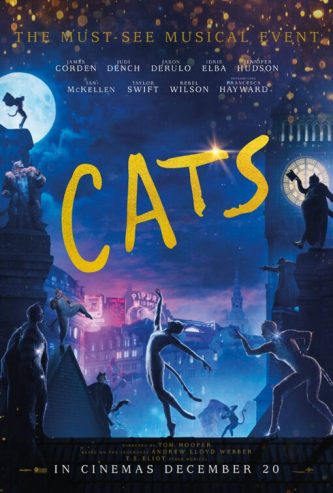
A film that has already joined the ranks of PAINT YOUR WAGON, AT LONG LAST LOVE and CAN’T STOP THE MUSIC, being a colossal music-fueled flop its makers really should have seen coming. Adapted from the long running Andrew Lloyd Webber stage extravaganza of the same name, CATS was directed by the Academy Award winner Tom Hooper, corralling a very of-the-moment cast that includes Judi Dench, Ian McKellan, Jennifer Hudson, Idris Elba, Taylor Swift and Rebel Wilson. The story, such as it is, involves weird looking were-cats who spend their days singing and dancing, with the ultimate goal being to get chosen by their leader to be taken to the “Heaviside Layer.” It’s all fleshed out via Andrew Lloyd Webber’s “classic” songs, whose worth is strictly a matter of opinion; I found them antic and repetitive, with the main theme reprised far too often. Those tunes fit in quite well with a film in which virtually every creative decision was wrong, from the handheld camerawork, which severely reduces the spectacle so integral to Hooper’s conception, to the CGI enhanced cat costumes, which with their moving ears, tails and whiskered faces are downright creepy. We also get human faced mice, dancing cockroaches and appearances by quite a few embarrassed-looking cat suited performers. If it weren’t so outrageously dull I’d call CATS a new bad movie classic. It may well become that anyway, as it takes real skill to make a movie this unremittingly atrocious.
2. UNICORN STORE
This film, the directorial debut of actress Brie Larson, is pretty awful, with that awfulness deriving largely from a wrongheaded and clichéd script that celebrates a most questionable Hollywood mainstay: the inner child. Larson’s major mistake as director was casting herself in the lead role of a quirky child-woman, in which guise she’s never the slightest bit convincing (it’s she who has to deliver the altogether ridiculous line “Am I pretty enough to be sexually harassed?”). Samuel L. Jackson plays a mysterious salesman who offers to sell Larson a unicorn, but are Jackson and the unicorn real? Given the film’s staunch follow-your-dreams thrust I think you can guess the arc, which inadvertently celebrates delusion and schizophrenia–although such an interpretation gives this shallow and confused product far too much credit. To see what Larson appears to have been attempting check out the 1987 Canadian import I’VE HEARD THE MERMAIDS SINGING, which hits many of the same notes, and does so from a grown-up perspective.
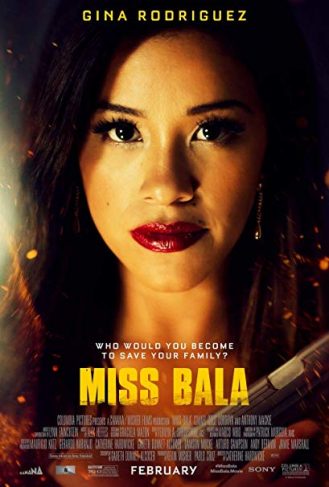 3. MISS BALA
3. MISS BALA
The latest in a long line of glorified TV movies. This one, remade from a well-received 2011 Spanish language film (which I haven’t seen), stars Gina Rodriguez as a makeup artist who accompanies a friend to Tijuana in preparation for a beauty pageant. There things quickly go to Hell, with Rodriguez witnessing a shoot-out and getting taken captive by the shooters. Rodriguez’s performance is sexy, harried and fierce, but the film is an unexciting bummer that suffers from a wimpy PG-13 aesthetic (I understand the original MISS BALA was much rougher) and action sequences that are so-so at best.
4. CLIFFS OF FREEDOM
This Greek made historical epic deserves points for ambition, but that, frankly, is all it deserves points for. Set in the early 1900s, it’s about the forbidden romance between a Greek village girl turned freedom fighter and a Turkish soldier during the Greek war for independence against the Ottoman Empire. A well intentioned film, certainly, but it suffers from TV movie worthy production values, substandard performances and an overly shrill, melodramatic atmosphere. See 1994’s BANDIT QUEEN instead.
5. EARTHQUAKE BIRD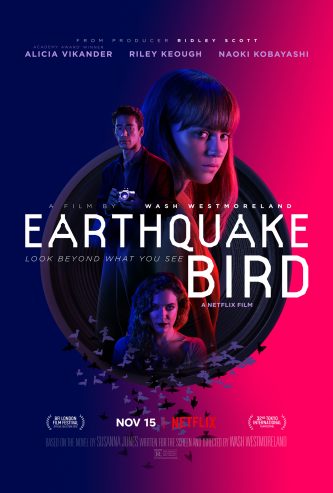
This film received a fair amount of enthusiastic pre-release hype, but upon finally being unveiled turned out to be standard-issue Netflix Cheese Whiz. Alicia Vikander plays a Caucasian hottie living in Tokyo who is interrogated by police regarding the disappearance of a young American woman (Riley Keogh); extensive flashbacks, which comprise the majority of the film, show that the two women were quite close, with a relationship that was decidedly complicated. As a psychothriller this extremely unevocative film falls flat, and nor does it work as a whodunit, as the narrative is too loose and indifferently constructed, taking nearly a full hour to really get going only to then spiral into a lame GIRL ON THE TRAIN-like arc. Vikander and Keogh do what they can, but neither makes much of an impression in a film that ultimately works best as a Tokyo travelogue.
6. THE SILENCE
A family finds itself under siege by creatures who hunt via sound…now where have we heard that concept before? In fairness, this film was based on a novel published in 2015, and so can’t really be accused of plagiarizing last year’s A QUIET PLACE, but the fact that the latter film beat this one to the punch makes it impossible not the compare the two—and that comparison is not at all favorable to THE SILENCE. It features THE CHILLING ADVENTURES OF SABRINA’S Kiernan Shipka as a hearing impaired teen who together with her family attempts to find a country haven from the sound hunting critters who have taken over the world. In contrast to A QUIET PLACE, which wisely kept its scope intimate and contained, THE SILENCE has a much broader, more expansive canvas, for which the filmmakers (in what is admittedly becoming a familiar complaint) lacked a proper budget, resulting in a lot of substandard CGI and lackluster action-suspense sequences.
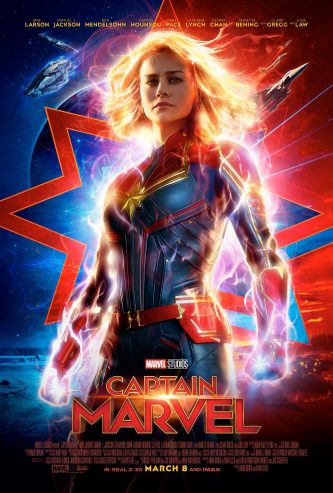 7. CAPTAIN MARVEL
7. CAPTAIN MARVEL
A Marvel movie with a difference: it’s the first such film to be headlined by female superhero, incarnated by Brie Larson. She’s about on par with Helen Slater in SUPERGIRL, being a great looking but hopelessly bland anchor who’s upstaged by the supporting cast. The filmmakers seem fully aware of this, as they gradually reduce Larson’s screen presence to the point that she finishes the film as a supporting character, with Samuel L. Jackson as THE AVENGERS’ Nick Fury allowed to blithely take over. The special effects are nothing special, and nor are the action sequences (which over-rely on medium shots and close-ups). Furthermore, the narrative, involving Captain Marvel being sent back to 1995 in order to save the world—in the process crashing through the roof of a Blockbuster Video outlet, stalking alien scumbags in human form and getting betrayed by turncoat Jude Law—is uninspiring, to say the least.
8. AVENGERS: ENDGAME
This is currently the top grossing movie of all time, something I’ll never understand. I’m admittedly burnt out on superhero fare, but even from a more receptive standpoint AVENGERS ENDGAME is a vastly overstuffed and under-conceived product. It suffers from a confusing narrative and an over-abundance of subplots, not to mention a plethora of extended cameos (by Michael Douglas, Robert Redford, Marisa Tomei, Cobie Smulders, Nathalie Portman, Gwyneth Paltrow and many others) that require a thorough knowledge of the preceding Marvel films in order to be understood. That dictum extends to the main players, who have a tendency to come and go unexpectedly; Brie Larson as Captain America, for instance, turns up early on and then disappears for much of the rest of the film, while GUARDIANS OF THE GALAXY baddie Karen Gillan gets a great deal of screen time. Why? Your guess is as good as mine.
9. TUFTLAND (KYRSYA-TUFTLAND)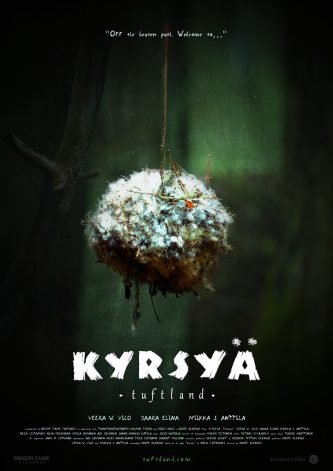
A young woman, reeling from a bad break-up, moves in with a feminist cult in this Finnish horror fest. As you might guess, the apparent wilderness paradise to which the heroine retreats turns out to be anything but, with the cult’s stern overseers proving fascistic and homicidal. Veera W. Vilo is engaging in the lead role, but the film doesn’t do her efforts justice. It’s atmospheric, yes, but also quite predictable and poorly structured, being, in essence, the Finnish answer to that awful WICKER MAN remake from 2006.
10. IN THE TALL GRASS
The 2012 novella IN THE TALL GRASS by Stephen King and Joe Hill was a satisfying exercise in contained horror that worked primarily because of its minimalism. About a brother and sister who find themselves trapped in a field of very tall grass together with a homicidal lunatic and a supernaturally endowed rock, the tale had the elemental power of single setting King classics like “The Raft” and GERALD’S GAME. This Netflix adaptation was made by Canada’s Vincenzo Natali, who would appear to be the ideal choice (based on his determinedly minimalistic films CUBE and NOTHING), which makes it all the more puzzling that he so grievously overcomplicates things. The set-up is identical to that of the story, but Natali insists on adding in time travel, teleportation and a bunch more characters. It all adds up to very little, despite the crisp cinematography and solid craftsmanship.
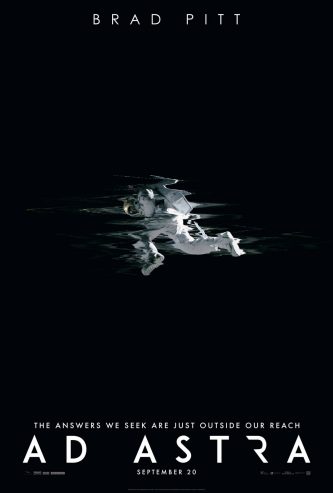 11. AD ASTRA
11. AD ASTRA
Brilliantly lensed this film definitely is, but not brilliantly enough to overcome the many, many problems. Brad Pitt headlines as a cosmonaut travelling the solar system in search of his father (Tommy Lee Jones), who it seems went mad trying to find aliens. As he did in THE LOST CITY OF Z, director James Gray has evident trouble maintaining his narrative focus, resulting in a severely meandering and uninvolving film. Leaving aside the many questionable and scientifically spurious elements (moon pirates? Man-eating space monkeys?? A water-filled underground tunnel beneath a rocket launch pad—on Mars???), one is left with an assortment of elements on loan from various other, much better movies. There are scenes of Pitt tumbling through space that are straight out of GRAVITY, missing father angst that closely recalls CONTACT and INTERSTELLAR, depictions of Pitt dealing with isolation a la THE MARTIAN and the ever-present specter of 2001: A SPACE ODYSSEY, which overhangs the whole film, and only makes it seem that much more misconceived.
12. THE MAN WHO KILLED DON QUIXOTE
I really wanted to like this film. It’s director Terry Gilliam’s long-in-the-works passion project, as documented in the film 2002 nonfiction film LOST IN LA MANCHA. THE MAN WHO KILLED DON QUIXOTE is a sort-of reimagining of DON QUIXOTE, with Adam Driver as a harried director who once made a film on the subject. He finds his reality dissolving after being confronted by the actor (Jonathan Pryce) he hired to play Quixote, who it seems is taking his role a bit too seriously. This leads to lot of highly picturesque adventures that see Driver playing the unwilling Sancho Panza to Pryce’s Quixote (to understand this movie, I should add, one must be well versed in its source material). All this is clumsily and confusingly related, complete with brief flashbacks to the film Driver shot, which only further muddies the narrative waters. Of course one doesn’t go to a Terry Gilliam movie for storytelling clarity, but even the filmmaking is substandard, with a shockingly pedestrian visual style interspaced with intrusive fish eye lenses. It looks like someone attempting an imitation Terry Gilliam film, and doing an extremely poor job.
13. JOJO RABBIT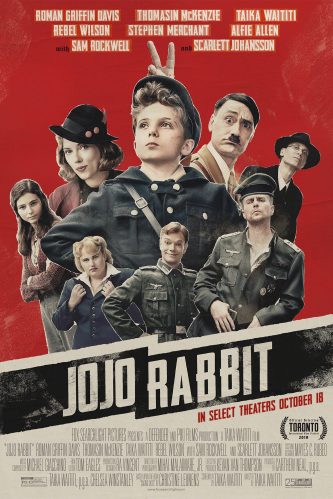
I know this film, directed by THOR: RAGNAROK’S Taika Waititi, has been highly regarded, but I didn’t think much of it. A black humored look into the Nazi youth camps in Germany of the 1930s, it has a haughty air to it but ultimately has all the depth of HEIL HONEY I’M HOME. Roman Griffin Davis plays the title character, a young boy growing up in perhaps the least accurate depiction of Nazi Germany in film history. Based on the dates and events depicted the narrative would appear to span around a full decade, yet Davis never ages. He wants desperately to become a Nazi, and chats with an imaginary Adolph Hitler (Waititi) that, as with most everything else here, is totally unconvincing. Scarlett Johansson, sporting a patently fake German accent, plays Davis’s mother, and Thomasin Mckenzie a Jewish girl sheltered by Johansson. Also on hand, playing Nazis, are Sam Rockwell, Rebel Wilson and Stephen Merchant(!). There are some affecting moments here and there (a most unexpected climactic death in particular), but for the most part the film is a misconceived bust.
14. A BEAUTIFUL DAY IN THE NEIGHBORHOOD
Another case of false advertising. This film was sold as a biopic of Fred Rogers, a.k.a. Mr. Rogers of the iconic kids’ show MR. ROGER’S NEIGHBORHOOD, but it’s actually about a grumpy journalist charged with doing a Rogers profile. Matthew Rhys plays said journalist, who’s upset about the death of his mother and taking it out on the world—can Mr. Rogers help cheer him up? Yes, that about sums up the narrative, whose major flaw is that, simply, Rhys and his problems aren’t very compelling. The Tom Hanks essayed Mr. Rogers is the more interesting character by far, and the hints we get of his private life—we’re informed that he apparently “has a temper” despite his ultra-chill, sexless demeanor, and somehow sired multiple children—seemed well worth exploring further.
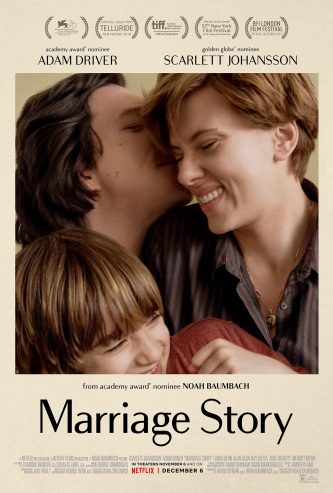 15. MARRIAGE STORY
15. MARRIAGE STORY
Divorce dramas have been a Hollywood staple since the 1980s. That period was when such fare was done right, in pics like SMASH PALACE and SHOOT THE MOON, which contained madness, physical abuse and kidnapping, showing how otherwise reasonable people are transformed into monsters by the pressures of a separation. MARRIAGE STORY, by contrast, is quite wimpy in its depiction of a divorce undergone by two nice upper-crust New Yorkers (Adam Driver and Scarlett Johansson), with the strife limited to a climactic shouting match and some overzealous lawyers (played, in a succession of showy supporting turns, by Laura Dern, Ray Liotta and Alan Alda). MARRIAGE STORY isn’t bad for what it is; the lead actors are both quite strong, and writer-director Noah Baumbach’s trademarked snappy dialogue feels germane to the characters and their situation (and so for once doesn’t revel in its own cleverness). Again, though, I prefer my divorce dramas tough and unsparing, which this one never is.
16. THE WANDERING EARTH (LIU LANG DI QIU)
Here we have China’s attempt at Hollywood-style blockbuster moviemaking: an unapologetically loud, unharmonious science fiction epic that prizes aggressive escapism above all else. The film’s makers evidently studied blockbusters like ARMAGEDDON and INTERSTELLAR quite closely, and utilized a very Hollywood-friendly framework in which CGI enhanced action sequences are utilized to prop up a narrative that’s perilously thin. The set-up involves the depletion of the sun, which has turned the surface of the Earth into an icy wasteland. Vast jet engines designed to propel the planet out of the Sun’s orbit have been constructed in major cities throughout the world, but a malfunction sets the Earth on a collision course with Jupiter. In keeping with its Hollywood forebears there are explosions a-plenty, a propulsive Hans Zimmer-esque score and a succession of intense action sequences that are largely incoherent. Of things like character development and narrative nuance there’s very little, with THE WANDERING EARTH ultimately feeling like exactly what it is: an inferior knock-off of a product we Americans do best.
17. CRAWL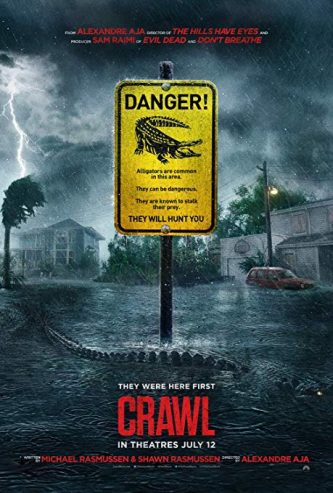
Slick but disposable situational horror from director Alexandre Aja. Don’t expect much in the way of nuance or intelligence from this flick, essentially a glorified SyFy Channel movie about a hurricane in Florida that causes mass flooding and, of course, looses a gaggle of hungry alligators. Caught up in melee are a plucky young swimmer (Kaya Scodelario) and her father (Barry Papper), trapped in the basement of their home as the flood waters rise and the gators proliferate. Aja orchestrates the resulting mayhem reasonably well, but is constantly tripped up by implausibility, with a heroine who’s apparently able to breathe under water and seems impervious to alligator bites.
18. RAMBO: LAST BLOOD
In which the RAMBO franchise goes grindhouse, fully embracing the old school exploitation aesthetic recalled by the subject matter. I approve, with my biggest complaint being that this movie is a bit too slick, with overly gaudy lighting and equally gaudy CGI effects. Such things simply don’t jibe with the hardboiled revenge-themed narrative that sees Sylvester Stallone as Rambo settling down on his family farmstead, only to get drawn back into the killing game when his teenaged niece (Yvette Monreal) is abused and held hostage by a gang of Mexican scumbags. This of course leads to a lot of killing as Rambo rescues his niece, but not in time to save her life, and eventually takes on his enemies in a booby-trap laden showdown in the catacombs under his house. Furthering the grindhouse feel is an extremely perfunctory and haphazardly developed narrative (due most likely to the fact that the film was heavily cut for its US release), with the emphasis on beatings and bloodletting throughout.
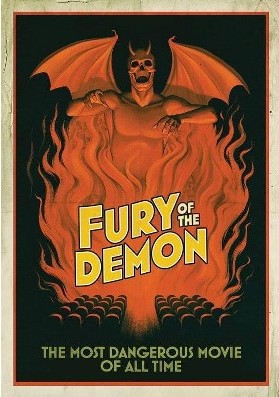 19. FURY OF THE DEMON (LA RAGE DU DEMON)
19. FURY OF THE DEMON (LA RAGE DU DEMON)
The idea of a cursed film is a popular one in the horror milieu, having been utilized in Tobe Hooper’s novel MIDNIGHT MOVIE and the John Carpenter directed “Cigarette Burns” MASTERS OF HORROR episode. This French quasi-documentary is the latest example of the trope, crossed with Peter Jackson’s FORBIDDEN SILVER (1995). Like that film, this one takes the form of an investigation into the existence of an elusive silent feature, in this case a late 19th Century obscurity entitled LA RAGE DU DEMON that might have been made by the legendary Georges Méliès. What makes it noteworthy is the fact that it caused mass hysteria during its initial screening, and did so again when a recovered print was shown in 2012. As written and directed by Fabien Delage, this film isn’t particularly adventurous or innovative, consisting almost entirely of talking head interviews with luminaries like Alexandre Aja, Christophe Gans and Rue Morgue editor Dave Alexander about LA RAGE DU DEMON, with no real conclusions about its seemingly malignant properties ever reached. Not that it matters, as the film in question, and the madness it allegedly inspired, are entirely fictional (based on the nonexistent books and names, such as filmmaker “Victor Sicarius,” that are referenced throughout). This film is ultimately most interesting for the biographical info it contains about Georges Méliès, including the revelation of the many imitation Méliès films that once proliferated.
20. HUSTLERS
A most unlikely #metoo anthem that dramatizes the true story of several strippers at NYC’s Scores club who ripped off rich male patrons by getting ‘em drunk and draining their bank accounts. Jennifer Lopez is, surprisingly, quite strong as the ringleader of the scheme, to the point that she all-but wipes her co-stars, who include Constance Wu, Julia Styles and Ciardi B., off the screen. Writer-director Lorene Scafaria vastly over-directs, with stylistic elements—an antic pop fueled soundtrack, a fast-moving, time-juggling editing scheme—borrowed from GOODFELLAS and CASINO, and inserts an altogether questionable political angle by making her heroines out to be Robin Hood-esque crusaders who steal from the rich and give to themselves. Another thing: J-Lo and Wu play strippers, yet they do little-to-no actual stripping.
21. ANIARA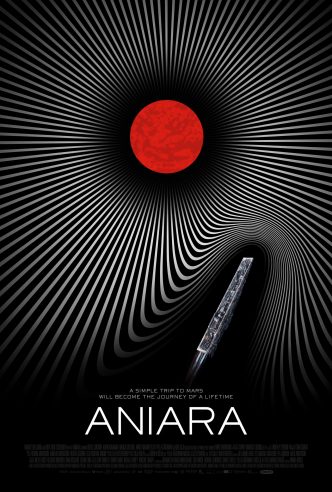
A downright frustrating viewing experience. This Swedish science fiction drama, an adaptation of the Harry Martinson authored epic poem of the same name, begins quite promisingly. About a community of settlers aboard a vast spaceship en route to Mars that gets knocked off course, the early scenes establish an atmosphere of staunch authenticity, and evince a strong and assured visual style. We learn that the ship’s pilots, who claim a course correction is imminent, have been lying to their passengers, who are fated to be stuck in orbit seemingly forever. This leads to widespread despair that manifests itself in mass orgies and the formation of bizarre suicide cults. Unfortunately, just as everything goes to Hell on the spaceship so too do the filmmakers seem to lose their inspiration, with things like motivation, consistency and coherency jettisoned in favor of a plodding and inconclusive muddle of a third act.
22. LUZ
This German import has a lot of good things, and just as many problems. The title character is a young woman cab driver (Luana Velis), involved in an accident that, we gradually learn, was caused by a demonically possessed seductress (Julia Riedler) who it seems is in love with young Luz. As crafted by writer-director Tilman Singer the narrative is a stop-and-start affair, commencing with a confusing bar-set encounter between Riedler and a rather imperious male psychiatrist (Jan Bluthardt) to whom she transfers her power (or something). Yet the succeeding sequence, set in a meeting room where Luz is hypnotized by Bluthardt and encouraged to relive the events of the accident, is superbly mesmerizing and imaginative. Unfortunately things degenerate from there as the proceedings grow increasingly dreamlike and abstract. I’m all for surrealism, but it’s becoming a substitute for a lack of inspiration on the part of genre filmmakers, which appears to have been the case here.
Looking Forward to…
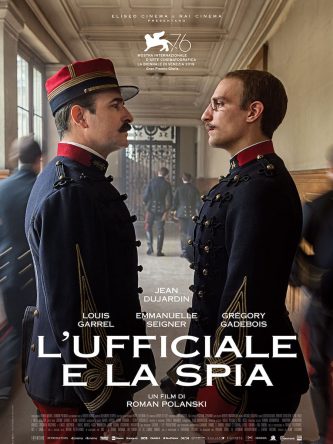 AN OFFICER AND A SPY (J’ACCUSE)
AN OFFICER AND A SPY (J’ACCUSE)
Roman Polanski’s latest film is said to be among his best. Its American release is currently in limbo, and likely to remain so, but you never know.
ANNETTE
The premiere English language film by France’s Leos Carax. That news alone should whet the appetite of any and all film buffs.
BENDETTA
Paul Verhoeven’s latest, a fact-based nunsploiter I anticipated last year, is apparently still in post-production. Here’s hoping it finally gets finished, and released, in 2020!
BILL & TED FACE THE MUSIC
The only 2020 sequel I’m anticipating with any degree of real interest. If you haven’t seen the original BILL & TED films with Keanu Reeves and Alex Winter (BILL AND TED’S BOGUS JOURNEY in particular), I strongly suggest you do so ASAP.
BLONDE
An adaptation of Joyce Carol Oates’s famed REPULSION-esque bio-novel about Marilyn Monroe, with Ana de Armas in the main role.
THE COLOR OUT OF SPACE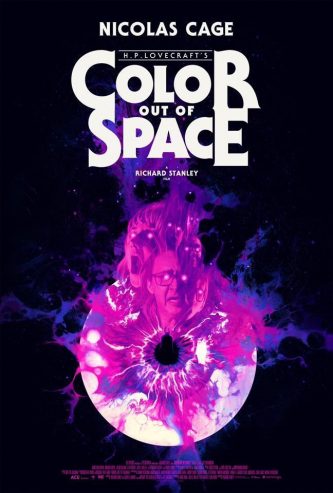
This one, a Nicolas Cage headlined adaptation of H.P. Lovecraft’s immortal story, doesn’t look very promising, but it is the first film to be directed by DUST DEVIL’s Richard Stanley in nearly thirty years, which alone renders it something of an event.
DARK ROMANCES
This SOV horror anthology isn’t new, having already been released (on VHS) back in the early nineties, but it’s set to make its long delayed digital debut sometime soon.
DEEP WATER
An adaptation of Patricia Highsmith’s classic novel (previously filmed by Michel Deville in 1981) from Adrian Lyne, starring Ben Affleck and (again) Ana de Armas.
DUNE
Adapting Frank Herbert’s DUNE isn’t a great idea in my view (there’s a reason it defeated both Alejandro Jodorowsky and David Lynch), but the director is BLADE RUNNER 2049’s brilliant Denis Villeneuve, so this film might conceivably be interesting.
EMA
The latest by JACKIE’s Pablo Larrain, a dark music-fueled character study that’s received great acclaim on the festival circuit.
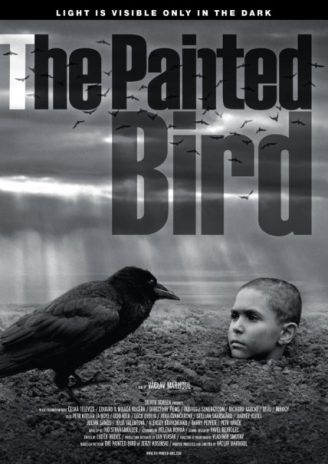 THE PAINTED BIRD
THE PAINTED BIRD
As adaptation of the late Jerzy Kosinski’s immortal novel (which Kosinski adamantly did not want to be filmed) about a Jewish boy’s nightmarish trek through Nazi-occupied Poland.
SAINT MAUD
This film has been described as cross between FIRST REFORMED and THE EXORCIST, a depiction of spirituality and madness that, it’s been claimed, breathes new life into an overworked genre.
